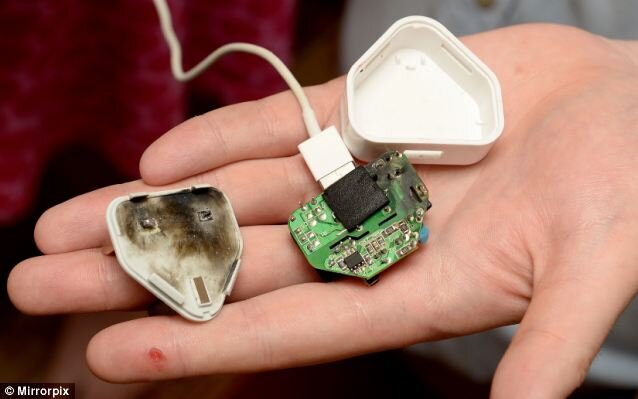Some fake chargers are causing fires 🔥
So if you shelled out over $1k for the newest Apple iPhone, you noticed it’s latest packaging update where they removed charging cables on iPhone 12 and later phones. AKA it is more tempting than ever to purchase cheaper alternatives to save that extra buck and juice up your phone. YES, the $20 Apple Lightning USB cable is pricey on top of its $20 power adaptor, but compared to the damages a counterfeit cable can cost you, I’d say go for the original. Smokey bear would be proud too.
Here’s what can happen with extended use of a fake charger:
1. The risk of explosion and shocks ⚡
Fake chargers are usually made carelessly, with no testing or quality control. This means they are more likely to leak and cause unwanted events, I’ll go into the tech behind it on the next few points but I’m not exaggerating about unwanted fires! I’ve heard so many horror stories of burnt hands from charging while on the phone, or when a phone explodes in the middle of the night causing a huge fire. I’ve even had chargers that would shock me if I held it wrong-- a big red flag.
An exploded charger that shocked father who was removing the plug and left him with burnt fingers.
2. Overheating
Fake producers don’t care for the quality of their products, as long as the product performs at bare minimum it’s a green light for them. They basically cheated on the test and graduated at the bare minimum. Apple cables have one of the highest wattage conductors making them safer cables to use, they are capable of containing high wattages and won’t freakout when you give it an overload of tasks. Well because, they’re trained for it, unlike the cheater. Cheater quality chargers don’t have the capability to hold even half of the wattage Apple cables can. During sudden spikes of electrical circuits, a fake cable can lose control over the extra amount of electricity and leak through its plastic-like materials, causing a fire. Yikes.
3. Cause battery damage
Fake charger manufacturers reverse-engineered and created knockoff charging cables to trick your phone into accepting unregulated electricity currents. I used to Jailbreak into my old iPhones to get all of its Apps for free, even though the games were fun in the first couple of weeks but by month 2 my phone was slowly dying. The forced current can overheat your phone’s internal system and cause battery damage. The shortcut is also the shortcut to killing your phone. You can check your iPhone battery health in your settings app, a new iPhone should always start at 100%.
Counterfeit chargers can harm your battery health by decreasing it’s maximum capacity.
4. No warranties if they stop working
According to Apple’s latest warranty, all of theirs and Beat’s products have a limited one year warranty. The limitation however, is if you were to use counterfeit accessories, jailbreak into it or unauthorizedly open your iPhone, the warranty is instantly broken. Which was what happened to me, I had to buy a new iPhone. If you bring your device to Apple, they won’t accept it under the warranty. In this case, it's best to keep your iPhone’s virginity strictly to authorized accessories and service providers unless you want to pay a heavy price.
How to spot a fake:
Designer handbags aren’t the only things we’re checking for counterfeits in 2020. It's the minor but essential tools like plugs and cables that need to be checked too.
FYI: 90% of Amazon.com’s chargers are fake!
1. Plug pin check
Turn off a socket and try plugging the charger in. If it’s difficult to get the plug pins into the socket, chances are it's a fake or the wrong size. It’s especially important to make sure your plugs are designed for where you live. American charger shouldn't be forced into a European socket, the electricity wattage isn’t the same and is very dangerous if forced. I once forced my American hairdryer to work in Indonesia, after 3 minutes of blowing my hair it started to produce an unusual burnt smell. I was literally asking for a fire at that point. Forcing a plug pin can risk leaking electricity especially during a use.
If you have a scale in your kitchen, compare its weight to an original to see if what you got from Amazon is authentic!
2. Markings and Labels
Look for the manufacturing name or logo, a fake is easy to spot and is usually wonky-looking. Trusty Google has a lot of images of how these areas should look like. Take a quick search on the web to call out any sus activity.
Apple has an in-depth article that goes into differentiating between fake chargers from their originals here.
Even the bright green sticker matters when you’re trying to differentiate between an original and fake!
3. “Accessory not supported”
Apple literally designed their devices to prompt these messages with any non-certified cables. Don’t say they didn’t warn ya.
Here are some brands you can trust your gadgets with:
Don’t worry, Apple doesn’t own the monopoly for chargers and we’re not forcing you buy from Apple. There are multiple third-party MFi (Made for iPod/iPhone/iPad)-certified accessory producers out there. If you’re choosing to use something outside of your phone brand’s charger, make sure to buy from one of these certified alternative producers:




